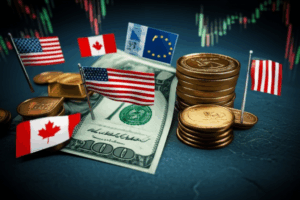S&P 500: Tariff Uncertainty Continues to Weigh on Stocks
The S&P 500, a bellwether for the broader U.S. equity market and a critical indicator of economic health, has been a battleground for investor sentiment in recent times. While resilient in the face of various economic shifts, its trajectory has consistently shown vulnerability to a singular, persistent factor: tariff uncertainty. This ongoing ambiguity surrounding global trade policies continues to cast a long shadow over corporate earnings forecasts, supply chain stability, and ultimately, the valuations of America’s largest publicly traded companies. For young adults navigating the complexities of the financial world, understanding this interplay between geopolitical strategy and market performance is paramount to grasping present market dynamics.
At the core of this market apprehension is the unpredictable nature of international trade relations. Escalating trade tensions, often characterized by the imposition or threat of new import duties and retaliatory measures, directly impact the operational landscape for multinational corporations. Businesses reliant on complex global supply chains find themselves in a precarious position, struggling to forecast costs, manage inventory, and plan future investments when the rules of trade can shift abruptly. This lack of clarity creates a significant impediment to long-term strategic planning, forcing companies to explore costly options like diversifying their manufacturing bases or absorbing higher input costs, both of which erode profit margins.
The impact of tariffs reverberates throughout the economic ecosystem. For instance, manufacturers sourcing components from countries subject to tariffs face increased expenses, which they must either absorb, pass on to consumers in the form of higher prices, or attempt to mitigate through supply chain re-engineering. Each of these responses has a distinct, often negative, impact on profitability. Higher consumer prices can dampen demand, while absorbed costs directly reduce earnings. Moreover, sectors heavily exposed to international trade, such as technology, automotive, and agriculture, have borne the brunt of these uncertainties, experiencing heightened volatility and, in some cases, significant revenue declines. The ripple effect extends beyond direct tariff targets, influencing overall consumer confidence and business investment decisions, which are crucial drivers of economic growth.
Investor sentiment, a notoriously fickle yet powerful force, reacts sharply to every development—or lack thereof—in trade negotiations. Positive headlines hinting at de-escalation can trigger relief rallies, while renewed threats of tariffs often lead to immediate market pullbacks. This sensitivity underscores how deeply ingrained trade policy has become in market psychology. Analysts frequently adjust their corporate earnings estimates downwards based on the evolving trade landscape, signaling a more challenging environment for companies to achieve their financial targets. This constant recalibration contributes to a sense of unease, leading some investors to adopt a more cautious stance, favoring less exposed sectors or seeking refuge in traditionally safer assets like government bonds, thereby redirecting capital away from equities.
While other factors, such as inflation, interest rate expectations, and domestic economic data, certainly play a role in shaping market performance, the persistent overhang of tariff uncertainty often amplifies their effects. A strong economy might otherwise provide a robust buffer against minor setbacks, but the foundational disruption caused by trade disputes makes even positive news appear fragile. The S&P 500’s movements during periods of heightened trade tension have been particularly instructive, demonstrating how perceived geopolitical risks can overshadow underlying economic fundamentals, compelling investors to prioritize risk management over growth opportunities.
Looking ahead, the market’s path remains closely tied to the resolution—or continued ambiguity—of global trade relations. While specific tariff regimes may fluctuate, the broader issue of trade policy predictability continues to be a defining challenge for global commerce. Investors, particularly those with a long-term horizon, are keenly observing whether major economic powers can establish a more stable framework for international trade. Until a clearer, more predictable trade environment emerges, the S&P 500 is likely to remain susceptible to the ebb and flow of tariff-related headlines, reminding young investors of the profound link between geopolitics and their portfolios. Understanding these macroeconomic currents is not just about tracking stock prices, but about comprehending the forces that shape the global economy.





